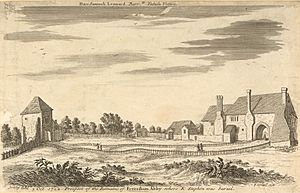Faversham Abbey facts for kids
Faversham Abbey was a very old and important monastery (a place where monks lived and prayed) located near the town of Faversham in Kent, England. It was built in a special style called Cluniac, named after a famous monastery in France.
Contents
The Abbey's Story
How Faversham Abbey Began
Faversham Abbey was started in 1148 by King Stephen and his wife, Matilda of Boulogne. Some monks from another monastery, Bermondsey Abbey, came to Faversham to help set up the new abbey and provide its first leader, called an abbot.
What Happened to the Abbey?
Many years later, in 1538, a big event called the Dissolution of the Monasteries happened in England. This was when King Henry VIII closed down many monasteries. Faversham Abbey was given to Sir Thomas Cheney, who then assigned it to Thomas Arden. Sadly, much of the abbey was destroyed that year. After this, the land where the abbey once stood became part of the Sondes family's property. Today, it is part of the grounds of Queen Elizabeth's Grammar School.
Royal Burials and a Mystery
Faversham Abbey was a special burial place for King Stephen, Queen Matilda, and their oldest son, Eustace IV of Boulogne. However, when the abbey was torn down, it was said that their bones were thrown into the nearby Faversham Creek. In 1964, their empty tombs were found near where the main part of the church (the choir) used to be. But there's also a special tomb in the nearby Parish Church where people believe their bones were later re-buried.
Digging Up the Past
In 1965, a team of archaeologists led by Brian Philp carefully dug up the abbey site. They created a full map showing exactly where everything was. The abbey was about 360 feet (110 meters) long. This made it shorter than Canterbury Cathedral but longer than Rochester Cathedral. The living areas for the monks, called the cloister and monastic buildings, were built on the northern side.
The abbey was built using different types of stone, including chalk, flint, ragstone, greensand, and Caen stone. The roof was likely made from slate that came all the way from south Devon, matching materials found near Modbury and Slapton Sands.
Ancient Roman Discoveries
Roman Building at Abbey Farm
In May 2019, the Kent Archaeological Field School made an exciting discovery at Abbey Farm, near the abbey site. They uncovered a large Roman building, about 150 feet (46 meters) long and 50 feet (15 meters) wide. Dr. Paul Wilkinson, who led the dig, explained that the building had stone walls.
Inside, they found many interesting things, like broken box flue tiles (which were used to send hot air up the walls to heat the rooms), glazed terracotta floors, and an untouched underfloor heating system called a hypocaust. They also found many ceramic roof tiles. Most of the wall plaster was white, but in the hot sauna room on the north side, they found plaster painted with green, red, and yellow panels. The building seemed to have two main areas: a bath house and a section used for farming activities.



